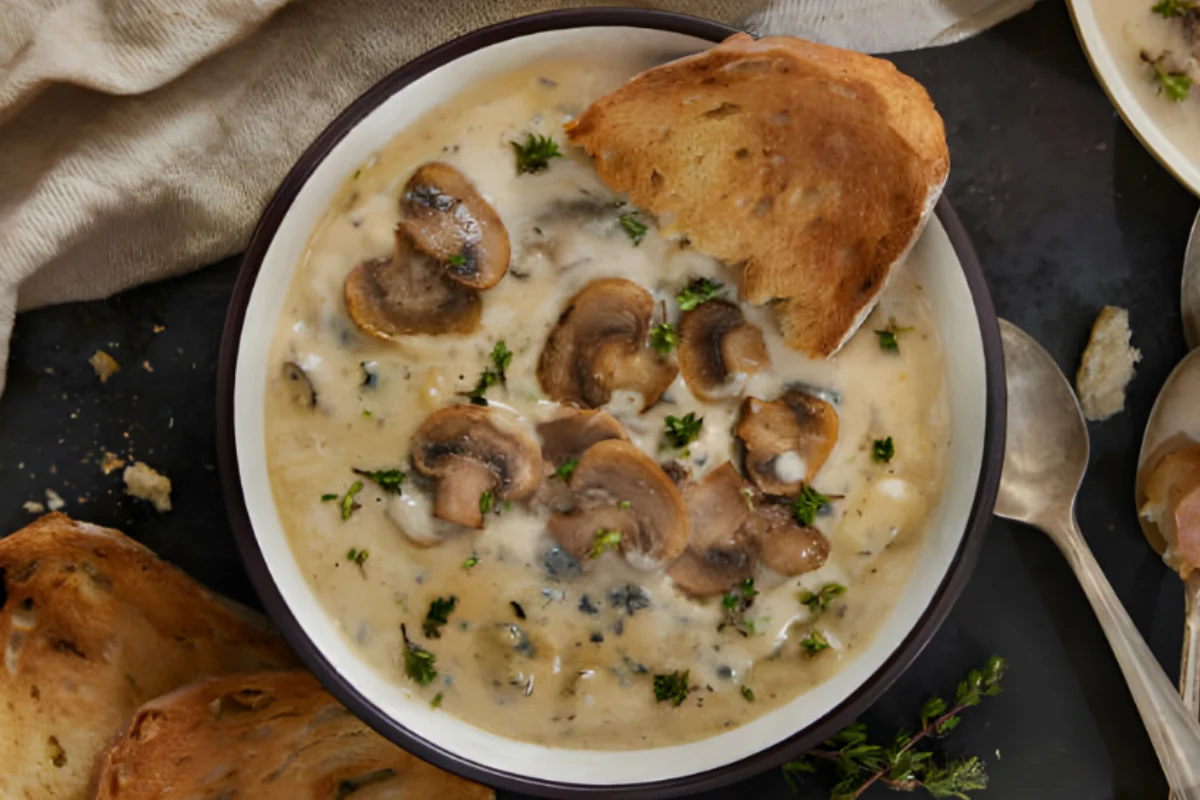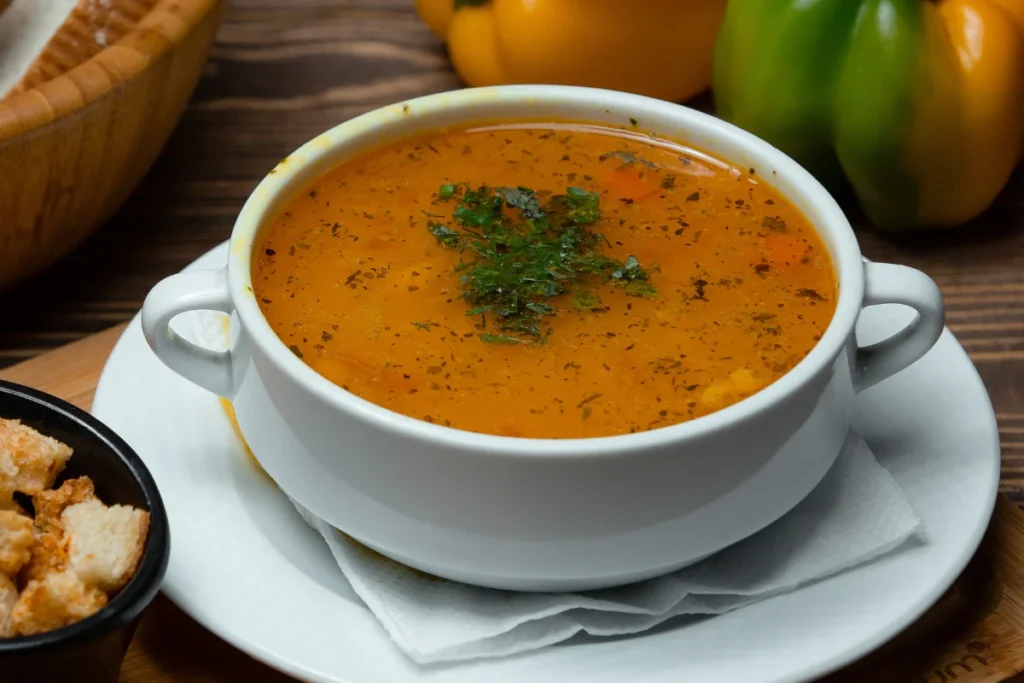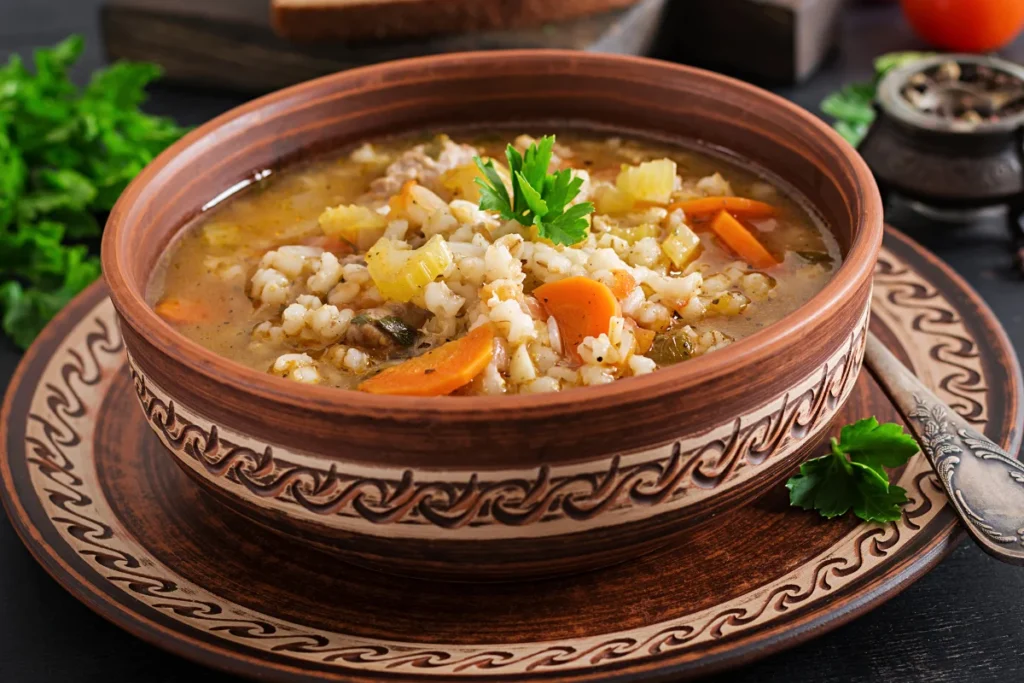Rich soups stand as the epitome of comfort food, offering a hearty, nourishing experience that transcends the simplicity of their ingredients. Characterized by their depth of flavor and luxurious textures, these soups transform basic components into something that’s both satisfying and complex. The key to a rich soup lies not just in the quality of its ingredients but in the techniques used to enhance and layer flavors.
- The foundation of any rich soup is a robust stock or broth. Whether homemade or carefully selected from store-bought options, the stock sets the stage for all the flavors to come. For insights on crafting the perfect base, Serious Eats offers advanced soup-making techniques that elevate the ordinary to the extraordinary.
- Building on this foundation, the use of aromatics and the method of browning ingredients are crucial steps. Aromatics like onions, garlic, and herbs infuse the soup with a base layer of flavor, while browning meats and vegetables introduces a savory depth. For a deeper dive into these techniques, Food52’s creative soup garnishing ideas not only enhance the final dish but also add layers of texture and interest.
By focusing on these elements, the journey to creating a rich and flavorful soup becomes an accessible art form, promising a rewarding experience for both the cook and those who gather to enjoy the final product.
Choosing the Right Stock
Choosing the right stock is pivotal in crafting a rich soup. This foundational element acts as the backbone, infusing every spoonful with depth and complexity. Whether you opt for a homemade concoction or a high-quality store-bought version, understanding the nuances of stock can elevate your soup from good to unforgettable.
- A homemade stock offers unparalleled flavor. Simmering bones, vegetables, and herbs for hours extracts every ounce of taste. It’s a labor of love that pays off in richness and authenticity.
- For those pressed for time, store-bought stocks can be a viable alternative. Look for options labeled as “low-sodium” to control the salt level in your soup, ensuring a balanced flavor profile.
- The choice between vegetable, chicken, beef, or fish stock depends on the type of soup you’re making. Each brings its unique flavor profile, enhancing the dish’s overall character.
- Incorporating umami-rich ingredients like mushrooms, tomato paste, or seaweed can add an extra layer of savoriness to any stock, homemade or store-bought.
- Remember, the best stock is one that tastes good enough to drink on its own. Taste your stock before adding it to your soup; if it’s bland, your soup will likely follow suit.
Transitioning smoothly between the preparation of your stock and the assembly of your soup ensures a cohesive flavor experience. A well-chosen stock not only serves as the foundation of your soup but also intertwines with the other ingredients, creating a harmonious blend that is both satisfying and complex. By giving due attention to this crucial component, you set the stage for a truly rich and flavorful culinary creation. Whether you’re making a hearty cowboy soup or a delicate vegetable broth, the quality of your stock will dictate the soup’s depth and character.
Aromatics and Base Flavors
Aromatics and base flavors are the soul of a rich soup, laying a foundation that is both fragrant and deeply flavorful. These ingredients, when skillfully combined, transform the liquid base into a culinary masterpiece. For inspiration on incorporating aromatics into your dishes, explore recipes that highlight their importance, such as the easy chicken salad chick broccoli salad, where the blend of flavors starts with the right base.
- Sofrito, mirepoix, and the Cajun trinity are classic examples of aromatic blends. Each culture has its own version, tailored to complement its unique culinary traditions.
- Starting your soup with these aromatic bases ensures a layered and complex flavor profile. They should be gently sautéed to unlock their full potential, releasing sweet and savory notes.
- Garlic, onions, and celery are staples, offering a universal appeal that underpins countless soup recipes. Their versatility makes them indispensable in the kitchen.
- The use of herbs and spices in conjunction with these vegetables introduces an additional layer of depth. Bay leaves, thyme, and rosemary are popular choices that infuse the soup with their distinctive aromas.
- For an extra boost of flavor, consider roasting or caramelizing your aromatics before adding them to the pot. This step enhances their natural sweetness and complexity.
By carefully selecting and preparing your aromatics and base flavors, you create a rich tapestry of taste that enriches the soup’s overall character. These initial steps are crucial in achieving a harmonious balance between the soup’s various components, ensuring that each spoonful is a testament to your culinary skill and attention to detail.
Browning for Depth
Browning ingredients is a key step in adding depth and complexity to your soup. This technique, known as the Maillard reaction, transforms simple components into rich, savory elements.
- Searing meats before adding them to the pot creates a crust that is packed with flavor. This caramelization enriches the soup’s base.
- Don’t overlook vegetables. Roasting or sautéing vegetables like onions, carrots, and mushrooms deepens their natural sweetness and adds a robust layer to your dish.
- For an umami boost, consider browning tomato paste until it’s a deep, rusty red. This concentrates its flavor, lending a rich savoriness to the broth.
- Deglazing the pan with a bit of stock or wine after browning meats and vegetables scrapes up flavorful bits, ensuring they’re incorporated into your soup.
- Remember, the goal is to achieve a golden brown color, not blackened or burnt. Moderate heat and constant attention are key to perfect browning.
Incorporating these browning techniques not only enhances the visual appeal of your soup but also ensures that every bite is imbued with a delicious complexity. This step is essential for creating a soup that is both nourishing and satisfying, with layers of flavor that unfold with each spoonful.
Layering Flavors
Layering flavors is crucial in crafting a soup that’s rich, complex, and deeply satisfying. This process involves adding ingredients at different stages to build a harmonious profile that’s both nuanced and robust.
- Start with a quality stock or broth as your base. Its flavor sets the tone for the entire soup.
- Incorporate aromatics like onions, garlic, and herbs early on. They provide a foundational fragrance and depth.
- Seasoning as you go is key. Adjust with salt, pepper, and other spices throughout cooking to enhance each ingredient’s contribution.
- Adding acidic elements such as tomatoes, lemon juice, or vinegar can brighten flavors, especially in richer, heavier soups.
- Consider the texture of your ingredients. Some should be added early to soften and meld into the broth, while others, like fresh herbs or greens, work best when added last to retain their color and bite.
- Taste and adjust frequently. The balance of salt, acid, and umami should evolve as the soup simmers, reaching its peak just before serving.
By attentively layering these flavors, you create a soup that’s not just a meal but an experience. Each spoonful should reveal a different note, a testament to the care and thought put into its preparation. This approach ensures your soup is not only nourishing but also a delight to the senses, offering warmth and comfort with every bite.
Creaminess Without Cream
Achieving creaminess in soup without the use of cream is both an art and a science, offering a healthier option that doesn’t compromise on texture or flavor.
- Blended vegetables, such as potatoes, cauliflower, or squash, naturally thicken soups, imparting a silky smoothness.
- Nut butters and tahini add richness and depth, introducing a subtle nutty flavor that complements both savory and sweet soups.
- Incorporating cooked beans or lentils not only thickens the broth but also boosts the protein content, making the soup more satisfying.
- A few pieces of stale bread blended into the soup can miraculously improve its texture, adding body without altering the flavor profile significantly.
- For a touch of exotic creaminess, coconut milk offers a dairy-free alternative that infuses soups with a light, tropical essence.
By exploring these alternatives, you can create a soup that’s luxuriously creamy yet light and healthful. These ingredients allow for a rich, enveloping experience in every spoonful, proving that creaminess can be achieved without heavy dairy. This approach not only caters to dietary preferences but also opens up a world of flavor possibilities, making your soup a comforting yet innovative dish.
Textural Contrast and Enhancements
Textural contrast in soup transforms a simple dish into a sensory delight, offering a balance between smooth bases and crunchy toppings.
- Croutons or toasted nuts provide a satisfying crunch that contrasts beautifully with creamy soups.
- Adding fresh herbs or microgreens just before serving introduces a burst of freshness and a slight bite.
- Seared or grilled meat toppings can add a chewy, savory element that complements smoother soup textures.
- For a unique twist, consider popcorn as a gluten-free alternative to croutons, adding an unexpected pop of texture.
Incorporating these elements not only enhances the soup’s appeal but also engages the palate in a more dynamic eating experience. By thoughtfully selecting toppings that contrast with the base, you elevate the dish, making each spoonful a discovery of flavors and textures. This approach ensures your soup is not just a meal but a memorable culinary journey.
Final Adjustments and Serving
Final adjustments and serving are crucial steps to ensure your soup shines in both flavor and presentation.
- Taste your soup one last time, adjusting for salt, acid, and spices as needed. This fine-tuning is key.
- Consider the consistency; add a little water if too thick or let it simmer longer if too thin.
- Heat your bowls before serving to keep the soup warm longer, enhancing the dining experience.
- Garnish with fresh herbs, a drizzle of quality oil, or a sprinkle of freshly grated cheese for added flavor and visual appeal.
These final touches are what transform a good soup into a great one, ensuring each bowl is a perfect blend of taste and texture. Serving the soup thoughtfully not only respects the ingredients and effort but also turns a simple meal into an occasion.
FAQs on Making Rich Soup
How can I make my soup more flavorful?
- Enhance your soup with a base of homemade stock and layer flavors using fresh herbs, roasted aromatics, and umami-rich ingredients like tomato paste or mushrooms. Season at every stage of cooking for depth.
What are the best ingredients for a rich soup?
- Start with a robust stock, add a mix of fresh and roasted vegetables for complexity, and incorporate proteins like seared meats or beans. Use fresh herbs and spices for added aroma and depth.
Can I make a rich soup in a slow cooker?
- Absolutely. Slow cookers are ideal for developing deep flavors, especially with ingredients that benefit from long, slow simmering. Start with a flavorful stock, add your ingredients, and let the cooker do the work.
How do I thicken my soup without using cream?
- Blend cooked vegetables like potatoes, cauliflower, or beans into the soup. Alternatively, a roux made from flour and butter, or a slurry from cornstarch and water, can thicken soups effectively.
Is it better to use homemade stock?
- While homemade stock is preferred for its flavor and control over ingredients, high-quality, low-sodium store-bought stocks are a convenient and effective alternative.
How can I add creaminess to vegan soups?
- Use coconut milk, blended cashews, or silken tofu to add a creamy texture without dairy. Avocado blended into the soup can also provide creaminess and richness.
What toppings can I add to my soup?
- Croutons, toasted nuts, fresh herbs, a swirl of cream or olive oil, grated cheese, or crispy bacon bits can add texture and flavor, elevating the soup’s appeal.
Can I freeze leftover soup?
- Most soups freeze well, except those with dairy or potato, which may change texture. Cool the soup quickly, store in airtight containers, and freeze for up to 3 months for best quality.
Conclusion
In conclusion, mastering the art of making rich soup is about understanding and applying a variety of culinary techniques, from selecting the right stock and layering flavors with aromatics and spices, to achieving depth with browning and adding creaminess without cream. Each step in the process contributes to the overall complexity and richness of the soup, turning simple ingredients into a comforting and satisfying meal.
Remember, the key to a great soup lies in the balance of flavors and textures, as well as the personal touches you bring to the recipe. Whether it’s through the choice of garnishes or the method of serving, making soup is as much about creativity as it is about cooking.
By keeping in mind the tips and techniques discussed, from the initial preparation of ingredients to the final adjustments before serving, you can craft soups that are not only nourishing but also a delight to the senses. So, embrace the process, experiment with different ingredients and flavors, and enjoy the journey of creating rich, flavorful soups that warm the heart and soul.
For more culinary inspiration and tips, dive into the diverse recipes and guides available at YummyBinge.com, where every meal becomes an adventure.


